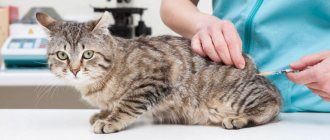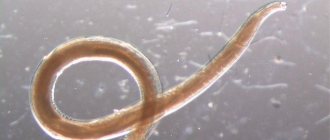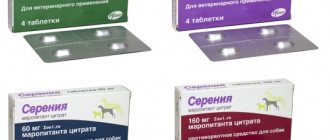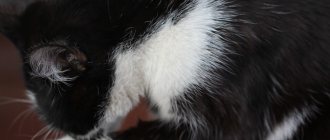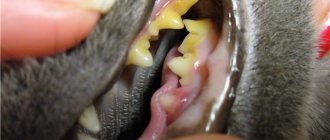Save the article:
Anandin is a drug that is widely used in complex therapy for infections of various etiologies. The product helps cope with inflammation caused by bacteria, microscopic fungi, viruses, and allergens. A variety of release forms, an almost complete absence of contraindications and side effects, and an affordable price make Anandin for cats a popular medicine.
Composition and release form of the drug
Anandin ear drops
The manufacturer produces Anandin for cats in three forms.
- Drops for eyes, nose and ears. Ophthalmic drops have a greenish color; they are indicated for the treatment of infectious diseases of the nasopharynx and eyes. An ear drug is prescribed for the treatment of otitis media; the solution has a yellowish tint. Anandin plus - ear drops - is used to treat parasitic diseases of the ears, since it additionally contains an active antiparasitic component - permethrin.
- Ointment for external use. It is used for the treatment of skin diseases, restoration of the epidermis after an infection or injury to the integument, and for fungal infections.
- Injection. It is used to treat a large number of diseases of various etymologies, as well as for preventive purposes, to support the immune system. Injected into the muscle.
The active ingredient of Anandin for cats is glucaminopropylcarbacridone (anandin). It is a synthetic low molecular weight cytokine inducer. The compound has a pronounced anti-inflammatory and immunomodulatory effect. It has a destructive effect on pathogenic microorganisms, stimulates the production of T- and B-lymphocytes, is active against viruses, and has a regenerative effect. Anandin is not a toxic drug and is excreted from the body approximately 20 hours after oral administration.
Indications for use
global $ads_google; //data-ad-slot=”2475549904″ $ads_google = empty($ads_google) ? false : true; ?> if ($ads_google == false) {?>
$ads_google = true; ?> } ?>
Since the drug has a pronounced immunomodulatory and anti-inflammatory effect, it can be recommended for many health problems in animals. Anandin is useful in the fight against acute and chronic diseases, and is also applicable to eliminate complications after serious illnesses. Indications for use are:
- Conjunctivitis and rhinitis (infectious, allergic).
- Acute, chronic or traumatic otitis.
- Beginning or advanced otodectosis.
- Severe condition due to immunodeficiency.
- Inflammation in internal organs.
- Traumatic injuries to the skin.
The medication helps in the fight against complications after viral infections. The localization of the outbreak can be different: eyes, ears, sinuses, skin, internal organs. The product strengthens the immune system and mobilizes the body's own forces.
How to use Anandin
Each form of the drug has its own instructions for use.
Drops in the eyes
- Drops in the eyes. The drug is instilled under the lower eyelid, two drops into each eye, in the morning and evening every day for at least 5 days. In severe cases, the medication can be used for two weeks.
- Nasal drops. The product is instilled into each nostril, 1-2 drops in the morning and evening every day for 5-7 days. For complicated, purulent rhinitis, treatment can be carried out for 14 days.
- Ear drops. When treating otitis media, the medicine is instilled every day for a week, 2-4 drops in the morning and evening (you can additionally do it at lunchtime). Anandin plus is used for ear mites as follows: once a day, 3 drops, daily for 3-7 days. This type of drug can be used for prevention.
- Injection. For treatment, the required volume of solution is calculated based on the ratio of 20 mg per 1 kg of cat’s body weight, and for preventive purposes - about 5 mg per 1 kg. The injection is given into the muscle once a day, for 3 days for the treatment of diseases and 10 days for prevention.
- Ointment. A small amount of the composition is applied in a thin layer to the site of skin damage and gently rubbed. There is no need to trim the fur or carry out other preparatory measures before applying the product. You can rub the ointment 1-3 times a day for about 5 days. During application, you should grab an area of healthy skin at a distance of about 1-2 cm from the wound.
Active substances
In drops for the eyes and nose, the role of the active substance is performed by glucaminepropylcarbacridone. All types of medicine contain 20 mg in 1 ml. It promotes regeneration, reduces inflammation, activates the formation of interferon, which strengthens the body. Glycerol and distilled water are additional substances.
The ear drops contain glucaminopropylcarbacridone and gramicidin C. The latter fights microbes and prevents the development of pathologies. In addition, isopropanol, castor oil and distilled water were added.
The ointment, in addition to glucaminopropylcarbacridone, contains petroleum jelly, castor oil, potassium salicylate and distilled water.
Side effects and contraindications
Anandin ointment
Although Anandin for cats is not a toxic drug, if the instructions are not followed and the composition is not carefully studied, the pet may experience side effects. It is especially important to monitor the animal’s reaction to the drug if the drug has not been used before. Possible adverse reactions include the following:
- itching (the animal rubs intensely against furniture or the floor);
- swelling (eyes, nose, nasopharynx);
- redness of the skin, rashes, hair loss;
- weakness, refusal of food and water;
- rare urination (indicates intoxication of the body).
There are few contraindications to the use of Anandin for cats: individual intolerance to the components of the drug and kidney disease. The latter refers to the use of the injection form of the drug.
Side effects.
Side effects and complications when using the drug in accordance with the instructions, as a rule, are not observed.
In case of increased individual sensitivity to the active components of the drug or an overdose, it should be washed off with water and detergent and the animal should be prescribed antihistamines and symptomatic drugs.
Special studies on pregnant and lactating animals have not been conducted. The possibility of using Anandin eye drops and intranasal drops for females during pregnancy and feeding the offspring is determined by the attending physician based on an assessment of the ratio of benefits to the possible risk of using the drug.
Advantages and disadvantages of the drug
Benefits of Anandin for cats:
- the drug can be used not only for treatment, but also for preventive purposes;
- the therapeutic effect is achieved in a short time;
- the product has a universal effect - can be used to treat bacterial, viral, fungal, and parasitic infections;
- Anandin is available in several forms, which allows for both internal and external effects on pathogenic flora;
- the medicine has virtually no contraindications;
- if you follow the instructions for use of the drug, the likelihood of side effects is reduced to zero;
- no need for concurrent use of other medications;
- all forms of release of the drug are combined with each other and, if necessary, can be used simultaneously;
- if there is a dog in the house, then it can also be treated with this remedy;
- Anandin has a low cost.
Among the disadvantages of the drug Anandin, a limitation in the duration of its use should be noted. The drug should not be used for longer than indicated in the instructions.
Features of the drug
Anandin has beneficial properties that give it maximum effectiveness incomparable to other analogues of the drug. The main useful properties include:
- the ability to quickly heal wounds, restore the skin, restore and give a healthy appearance to the coat;
- elimination of microorganisms of any kind and form;
- the ability to stimulate the immune system and strengthen the body’s defense response and prevent the development of possible pathological processes;
- combating inflammatory processes and restoring the tissue system.
Recommendations for treating cats with Anandin
Anandin injection
To increase the effectiveness of treatment and achieve a speedy and complete recovery of your pet, you should follow some recommendations when using the medicine Anadin.
- Before using ear drops, your cat's ears should be carefully cleared of any buildup. To do this, moisten a cotton swab with Anandin ear drops (you can use saline solution), and then carefully wipe the inner surface of the ears from the inside out, without penetrating deep. Only after this can the medicine be instilled.
- Wounds on the surface of the skin also need to be cleaned first if they contain purulent discharge or blood. It is not recommended to tear off the crusts.
- When instilling eye drops, your pet's eyes also need to be rinsed. Plain water or weak tea is suitable for this.
- After instillation, the cat needs to be held in your arms for a while so that it does not shake its head and splash the medicine.
- When using drops, you need to be careful not to mix up the bottles. It is unacceptable to use ear drops to treat eyes.
- Injections should be given to the cat using a sterile syringe in compliance with all aseptic measures.
- It is necessary to periodically check the expiration date of the medicine when storing it at home.
When will it be useful?
The drug is useful in many situations:
- Viral infections. Resists staphylococcus, hepatitis, plague and fungi, which cause significant harm to pets. In rare cases, death can even occur. To prevent this, it is worth purchasing effective medications.
- Inflammatory processes.
- Conjunctivitis and rhinitis. It has a therapeutic effect, eliminating puffiness of the eyes, nasal congestion, and normalizing general well-being.
To prevent the medication from causing harm, carefully read the instructions and follow all its requirements. The dosage and duration of treatment depends on the condition of the cat. The positive effect is noticeable after the first procedures.
Analogs and reviews
At the moment, Anandin has no analogues among drugs used in veterinary medicine. At the same time, reviews about the medicine are very diverse: from enthusiastic to extremely negative. An important role in this case is played by the fact that many owners, hoping for the versatility of the drug and the absence of contraindications, purchase and use it themselves. To avoid side effects and to ensure your pet’s recovery and not a worsening of its condition, you must show the animal to a veterinarian before using the product.
Expiration date and how to store?
Unused medicine is stored in a tightly closed container at a temperature of 0-25 degrees in a dry, dark place. Use after the expiration date, which is two years, is not allowed.
Interaction with other drugs
There are no contraindications for simultaneous use with other medications.
Anandin plus
Purpose
Prescribed for any inflammatory processes on the mucous membrane in cats, occurring mainly due to a decrease in the immune functions of the body. Such diseases include:
- otitis;
- conjunctivitis;
- rhinitis;
- otodectosis;
- slow regeneration of damaged skin;
- complex stage of immunodeficiency.
They are manifested by the following symptoms:
- labored breathing;
- eye and nasal discharge;
- lacrimation;
- swelling of the eyelids and sore ears;
- intolerance to bright light;
- sneezing.
In such a situation, it is recommended to urgently contact a veterinary clinic. Ignoring these manifestations leads to serious complications in the form of a chronic form. After establishing an accurate diagnosis, the doctor prescribes appropriate treatment.
Anandin is often prescribed as a prophylactic agent, which helps increase immunity and suppress the proliferation of pathogenic microorganisms in the bud. This is especially true for unvaccinated pets who have free access to the street. Even if there is the slightest suspicion that your cat has an infection, you should immediately administer a prophylactic dosage (2 drops into each nasal or ear canal) before contacting the veterinarian. This will ease the animal's condition.
Operating principle
The active substance has bactericidal and bacteriostatic properties. Within a short time, it suppresses not only active pathogenic microflora, but also bacteria that are at rest.
The drug destroys neurotropic, dermatotropic, pantropic viruses that cause dangerous diseases such as canine distemper, viral hepatitis, and polioencephalitis. The active substance stimulates the production of endogenous interferon, resulting in increased cat immunity.
The maximum concentration of the drug in the blood is observed one hour after use. Residues are excreted unchanged from the body by the kidneys after 22 hours.
Experience in the use of combination drugs in the treatment of rhinitis and sinusitis in children
The incidence of sinusitis is still quite high. According to various authors, diseases of the nose and paranasal sinuses affect from 17 to 22% of the child population. One of the significant factors in the pathogenesis of acute and especially chronic inflammatory diseases of the nose and paranasal sinuses is a violation of the mechanism of mucociliary transport. This is most often associated with swelling of the mucous membrane, excessive formation and increased viscosity of nasal secretions, which entails a disorder of drainage, respiratory, secretory and olfactory functions. The most common treatment for sinusitis is oral or intramuscular antibiotics. Since the supply of antibiotics from the bloodstream to the site of inflammation is limited, the treatment of sinusitis must be comprehensive.
First of all, this should concern improving ventilation, as well as drainage of the paranasal sinuses and nasopharynx.
Until now, otolaryngologists do not always practice prescribing adequate mucoregulating drugs included in the treatment regimen for patients with sinusitis, which, by thinning the thick viscous secretion and improving mucociliary clearance, help remove secretions from the sinuses. Among the drugs that affect mucociliary activity, previously used drugs that stimulate the liquefaction of rhinobronchial secretions, or so-called mucolytics, which change the viscosity of the secretion, affecting its physicochemical properties. We are talking about enzymes (trypsin, chymotrypsin, etc.), which are not currently used due to side effects.
Drugs that reduce surface tension also have a mucolytic effect, i.e., they act on the gel phase of the discharge and dilute both sputum and nasopharyngeal secretions. This group includes fluimucil (N-acetylcysteine), the action of which is associated with the ability of the free sulfhydryl group of N-acetylcysteine to cleave the intermolecular disulfide bonds of mucus glycoprotein aggregates, exerting a strong liquefying effect and reducing viscosity in relation to any type of secretion: purulent, mucopurulent, mucous . The peculiarity of fluimucil is that in addition to the direct mucolytic effect, N-acetylcysteine has powerful antioxidant properties and is able to protect the respiratory system from the cytotoxic effects of inflammatory metabolites, environmental factors, and tobacco smoke.
In the group of mucolytics, combination drugs are of great interest, namely rhinofluimucil, which, in addition to N-acetylcysteine, which dilutes the secretions, includes a sympathomimetic - tuaminoheptane sulfate, which has a mild vasoconstrictor effect and does not cause excessive dryness of the mucous membrane. After the disulfide bridges break, mucus and phlegm lose their viscosity, begin to absorb water and are gently removed when blowing the nose, sneezing, or coughing. Indications for the use of rinofluimucil are:
- prolonged purulent sinusitis with viscous thick secretion;
- chronic rhinitis with the formation of crusts in the nasal cavity and nasopharynx;
- vasomotor rhinitis with thick viscous discharge.
The effectiveness of the drug was assessed in a group of 55 patients aged 6 to 14 years; rinofluimucil was injected one dose into each half of the nose 3-4 times a day, the course was 6-7 days. The condition of the children was assessed by their subjective feelings before and after using the drug, as well as by objective criteria (reduction of hyperemia and congestion in the mucous membrane, improvement of nasal breathing, reduction of mucus, change in its rheological properties).
After 6-8 inhalations of rhinofluimucil, positive dynamics were noted.
The result of using the drug was assessed as follows: 70% of patients - excellent; 20% - good; 10% - satisfactory.
| Drawing. Comparative results of treatment with the antibiotic fluimucil IT and traditional methods |
There were no side effects from the use of the drug. The advantage of rhinofluimucil is that it acts on the surface of the mucous membrane and, by thinning the mucus, reduces its viscosity and promotes the productive physiological act of cleansing the nasal cavity.
The next drug that you should pay attention to is the fluimucil antibiotic IT, which combines two components in one dosage form: N-acetylcysteine and thiamphenicol glycinate (thiamphenicol is a drug from the chloramphenicol group). The spectrum of antimicrobial activity of the drug is presented in table. 1 (Clinical pharmacology of antibacterial drugs/Ed. Yu. B. Belousov, 1988).
The drug has a combined antibacterial and mucolytic effect and is recommended for the treatment of respiratory diseases caused by bacterial infection and accompanied by the formation of a thick viscous secretion. The antimicrobial activity of thiamphenicol is due to its interference with the synthesis of bacterial proteins. Recent studies have shown that the combination of thiamphenicol and N-acetylcysteine allows the drug to retain its unconjugated form and reach the site of inflammation in concentrations sufficient to create a bactericidal effect. The drug exhibits mucolytic activity against any type of secretion - mucous, mucopurulent, purulent. Fluimucil antibiotic IT facilitates the separation of sputum and nasal mucus. The drug is effective when administered into the paranasal sinuses.
We have data on treatment with the drug fluimucil-antibiotic IT in 37 children, of which 17 were diagnosed with acute sinusitis, 10 with exacerbation of chronic sinusitis and 10 with exacerbation of chronic purulent sinusitis. The control group of patients was treated using the traditional method without the use of fluimucil antibiotic. Comparative data is presented in the figure.
The drug was used for washing the paranasal sinuses after punctures or after surgery, including after endonasal opening of the ethmoidal labyrinth cells. Good results were obtained after 2-3 rinses: nasal breathing improved, swelling of the nasal mucosa decreased, the amount of secretion decreased, and its purulent nature disappeared. Indications and methods of use of the drug are presented in table. 2.
The effectiveness of the IT antibiotic fluimucil is determined not only by its antibacterial effect, but also by its ability to ensure rapid and complete removal of exudate, which in turn enhances the antibacterial effect.
Literature
- Ammosova S.P., Chuchalin A.G. et al. The effectiveness of N-acetylcysteine therapy in the treatment of liquidators of the Chernobyl accident with chronic bronchitis.
- Balyasinskaya G. L., Minasyan V. S., Kachkaeva E. D. The use of rinofluimucil in the treatment of rhinitis in children: Collection of works of the department. M., 2001. pp. 162-165.
- Garashchenko T. I., Bogomilsky M. R., Radtsig E. Yu. Mucoactive drugs in the treatment of non-purulent diseases of the middle ear: Collection of works of the department. M., 2001. pp. 157-162.
- Levin A. R., Zaitseva O. V., Vykhristyuk O. F., Kasyanov E. N. Results of the use of acetylcysteine in the complex treatment of children with bronchopulmonary diseases // Pediatrics. 1995. No. 5. P. 66-68.
- Sinopalnikov A.I., Klyachkina I.L. The place of mucolytic drugs in the complex therapy of respiratory diseases // Russian Medical Bulletin. No. 4. pp. 9-10.
- Samsygina G. A. et al. Experience in the use of acetylcysteine in the treatment of acute and chronic respiratory diseases in children // Pediatrics. 1995. No. 3. P. 76.
- Rizzata J. Aerosol antibiotics for the treatment of respiratory infections. The focus is on thiamphenicol glycinate acetylcysteinate. Publishing house "Mattioli", 1985, Therapist, 2001. No. 9. P. 1-6.
Note!
Fluimucil antibiotic IT has the following pharmacological and therapeutic properties:
- High bioavailability of the drug.
- High antibacterial activity, which is achieved thanks to a special dosage form.
- High mucolytic activity, ensuring the restoration of mucociliary clearance and the removal of pathological microorganisms.
- By creating a high therapeutic concentration of both an antibiotic and N-acetylcysteine in the affected organs.
Price indicator
The average cost of Anandin, according to statistics from several pharmacies from different regions, is:
- intramuscular solution - 165 rub. per packaging;
- drops for ears - 70–75 rub. per bottle 5 ml;
- eye drops - within 80 rubles. for a 5 ml bottle;
- external ointment - 50 rub. per tube.
It is recommended that every cat owner have Anandin in their medicine cabinet, as it is a universal remedy for many diseases. The medicine is particularly effective in treating rhinitis, otitis and conjunctivitis, regardless of the nature of its origin.
